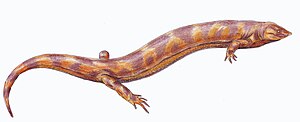Lepospondyli
| Lepospondyli | ||||||||||
|---|---|---|---|---|---|---|---|---|---|---|

The microsaur Pelodosotis elongatum , graphic reconstruction |
||||||||||
| Temporal occurrence | ||||||||||
| Carbon to Permian | ||||||||||
| 326.5 to 251 million years | ||||||||||
| Locations | ||||||||||
|
||||||||||
| Systematics | ||||||||||
|
||||||||||
| Scientific name | ||||||||||
| Lepospondyli | ||||||||||
| Zittel , 1888 |
The Lepospondyli ("Hüllen- or Hülsenwirbler") are an extinct group of amphibian-like, primitive and morphologically very diverse terrestrial vertebrates (Tetrapoda). Fossil remains of the Lepospondyli were found almost exclusively in North America and Europe, only the Nectridea are also known from North Africa.
features
In contrast to the mostly large and heavily built Temnospondyli , the Lepospondyli are rather small, most forms were only 10 to 20 cm long, and are similar to today's tail or sneak amphibians . Her skeleton was only weakly ossified. The enamel layers of their strong teeth were not folded like a labyrinth , their snouts were short, their skulls were compact. The rear edge is straight, an ear slit is missing. The ribs were long and curved. The eponymous and most important common feature are the spindle-shaped vertebrae . This shape of the vertebral bodies could be an adaptation to the small body size and thus a reduction feature. In this case, the lepospondyli could be descended from various primitive land vertebrates of the Upper Devonian or Mississippian ("Lower Carboniferous") and their monophyly is therefore questionable.
Systematics
In the traditional system , they are listed as a subclass of amphibians , but the relationship to today's amphibians is unclear. The Lepospondyli could be their sister group , but they could also be a non-monophyletic association of core group representatives of the amphibians. At present, however, there is more evidence that they belong as a basal branch to the trunk group of the Amniota . After a new investigation of the kinship relationships of the early terrestrial vertebrates, a team of scientists comes to the conclusion that Westlothiana is basal to the lepospondyli and forms a clade with them.
Cladogram according to Benton 2007 with addition according to Ruta et al.
-
Land vertebrates (Tetrapoda)
- basal tetrapods
- † Temnospondyli → (Modern amphibians )
- unnamed monophylum
- unnamed monophylum
- † West Lothiana
- † Lepospondyli
- Reptiliomorpha
- unnamed monophylum
Sub-taxa
The lepospondyli are divided into six subgroups according to anatomical features.
literature
- Robert L. Carroll : Paleontology and Evolution of the Vertebrates , Thieme, Stuttgart (1993), ISBN 3-13-774401-6
- Wilfried Westheide & Reinhard Rieger : Special Zoology Part 2: Vertebrae and Skull Animals , 1st edition, Spectrum Akademischer Verlag Heidelberg • Berlin, 2004, ISBN 3-8274-0307-3
- Robert Reisz: Lepospondyls and Lissamphibians. PDF
Individual evidence
- ↑ Marcello Ruta, Michael I. Coates & Donald LJ Quickie (2003): Early tetrapod relationships revisited. Biological Reviews, 78, pp 251-345 doi : 10.1017 / S1464793102006103
- ↑ Michael J. Benton : Paleontology of the vertebrates. 2007, ISBN 3-89937-072-4
Web links
- Laurin, Michel: Terrestrial Vertebrates. Stegocephalians: Tetrapods and other digit-bearing vertebrates. Version October 13, 2008. in The Tree of Life Web Project
